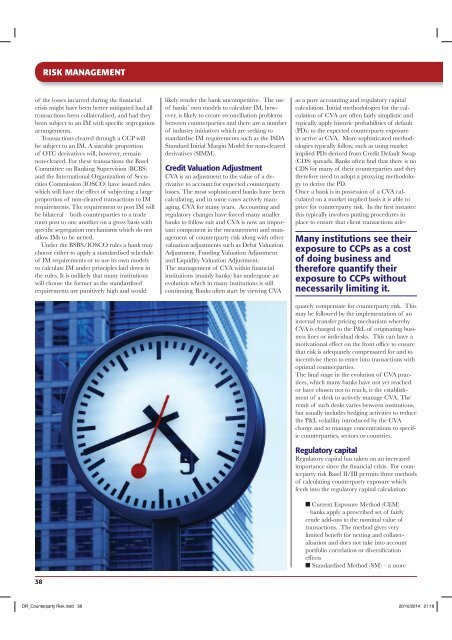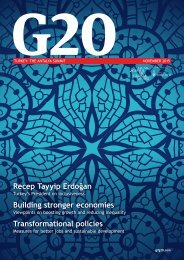SOURCE: Derivatives Special Report
SOURCE Derivatives Special Report provides expert analysis and information on the derivatives markets and provides insight into the large and complex challenges being faced by the global derivatives industry. SOURCE Derivatives Special Report strives to identify emerging risks and mitigation strategies, while covering the fascinating people who drive the industry forward. The magazine will be published in June and November 2015 and quarterly from 2016 with the launch of our website, sourcederivatives.com in September 2015. SOURCE Derivatives Special Report is the leading analytical publication on derivatives, providing a detailed study of theoretical models and how they are used in practice. SOURCE Derivatives Special Report gives you results-oriented analysis and statistical information on derivative products and techniques.
SOURCE Derivatives Special Report provides
expert analysis and information on the derivatives
markets and provides insight into the large and
complex challenges being faced by the global
derivatives industry.
SOURCE Derivatives Special Report strives to
identify emerging risks and mitigation strategies,
while covering the fascinating people who drive
the industry forward.
The magazine will be published in June and
November 2015 and quarterly from 2016 with
the launch of our website, sourcederivatives.com
in September 2015.
SOURCE Derivatives Special Report is the
leading analytical publication on derivatives,
providing a detailed study of theoretical models
and how they are used in practice.
SOURCE Derivatives Special Report gives you
results-oriented analysis and statistical information
on derivative products and techniques.
Create successful ePaper yourself
Turn your PDF publications into a flip-book with our unique Google optimized e-Paper software.
RISK MANAGEMENT<br />
of the losses incurred during the financial<br />
crisis might have been better mitigated had all<br />
transactions been collateralised, and had they<br />
been subject to an IM with specific segregation<br />
arrangements.<br />
Transactions cleared through a CCP will<br />
be subject to an IM. A sizeable proportion<br />
of OTC derivatives will, however, remain<br />
non-cleared. For these transactions the Basel<br />
Committee on Banking Supervision (BCBS)<br />
and the International Organization of Securities<br />
Commission (IOSCO) have issued rules<br />
which will have the effect of subjecting a large<br />
proportion of non-cleared transactions to IM<br />
requirements. The requirement to post IM will<br />
be bilateral – both counterparties to a trade<br />
must post to one another on a gross basis with<br />
specific segregation mechanisms which do not<br />
allow IMs to be netted.<br />
Under the BSBS/IOSCO rules a bank may<br />
choose either to apply a standardised schedule<br />
of IM requirements or to use its own models<br />
to calculate IM under principles laid down in<br />
the rules. It is unlikely that many institutions<br />
will choose the former as the standardised<br />
requirements are punitively high and would<br />
likely render the bank uncompetitive. The use<br />
of banks’ own models to calculate IM, however,<br />
is likely to create reconciliation problems<br />
between counterparties and there are a number<br />
of industry initiatives which are seeking to<br />
standardise IM requirements such as the ISDA<br />
Standard Initial Margin Model for non-cleared<br />
derivatives (SIMM).<br />
Credit Valuation Adjustment<br />
CVA is an adjustment to the value of a derivative<br />
to account for expected counterparty<br />
losses. The most sophisticated banks have been<br />
calculating, and in some cases actively managing,<br />
CVA for many years. Accounting and<br />
regulatory changes have forced many smaller<br />
banks to follow suit and CVA is now an important<br />
component in the measurement and management<br />
of counterparty risk along with other<br />
valuation adjustments such as Debit Valuation<br />
Adjustment, Funding Valuation Adjustment<br />
and Liquidity Valuation Adjustment.<br />
The management of CVA within financial<br />
institutions (mainly banks) has undergone an<br />
evolution which in many institutions is still<br />
continuing. Banks often start by viewing CVA<br />
Many institutions see their<br />
exposure to CCPs as a cost<br />
of doing business and<br />
therefore quantify their<br />
exposure to CCPs without<br />
necessarily limiting it.<br />
as a pure accounting and regulatory capital<br />
calculation. Initial methodologies for the calculation<br />
of CVA are often fairly simplistic and<br />
typically apply historic probabilities of default<br />
(PDs) to the expected counterparty exposure<br />
to arrive at CVA. More sophisticated methodologies<br />
typically follow, such as using market<br />
implied PDs derived from Credit Default Swap<br />
CDS spreads. Banks often find that there is no<br />
CDS for many of their counterparties and they<br />
therefore need to adopt a proxying methodology<br />
to derive the PD.<br />
Once a bank is in possession of a CVA calculated<br />
on a market implied basis it is able to<br />
price for counterparty risk. In the first instance<br />
this typically involves putting procedures in<br />
place to ensure that client transactions adequately<br />
compensate for counterparty risk. This<br />
may be followed by the implementation of an<br />
internal transfer pricing mechanism whereby<br />
CVA is charged to the P&L of originating business<br />
lines or individual desks. This can have a<br />
motivational effect on the front office to ensure<br />
that risk is adequately compensated for and to<br />
incentivise them to enter into transactions with<br />
optimal counterparties.<br />
The final stage in the evolution of CVA practices,<br />
which many banks have not yet reached<br />
or have chosen not to reach, is the establishment<br />
of a desk to actively manage CVA. The<br />
remit of such desks varies between institutions,<br />
but usually includes hedging activities to reduce<br />
the P&L volatility introduced by the CVA<br />
charge and to manage concentrations to specific<br />
counterparties, sectors or countries.<br />
Regulatory capital<br />
Regulatory capital has taken on an increased<br />
importance since the financial crisis. For counterparty<br />
risk Basel II/III permits three methods<br />
of calculating counterparty exposure which<br />
feeds into the regulatory capital calculation:<br />
■ Current Exposure Method (CEM)<br />
– banks apply a prescribed set of fairly<br />
crude add-ons to the nominal value of<br />
transactions. The method gives very<br />
limited benefit for netting and collateralisation<br />
and does not take into account<br />
portfolio correlation or diversification<br />
effects<br />
■ Standardised Method (SM) – a more<br />
38<br />
DR_Counterparty Risk.indd 38 20/10/2014 21:18
















